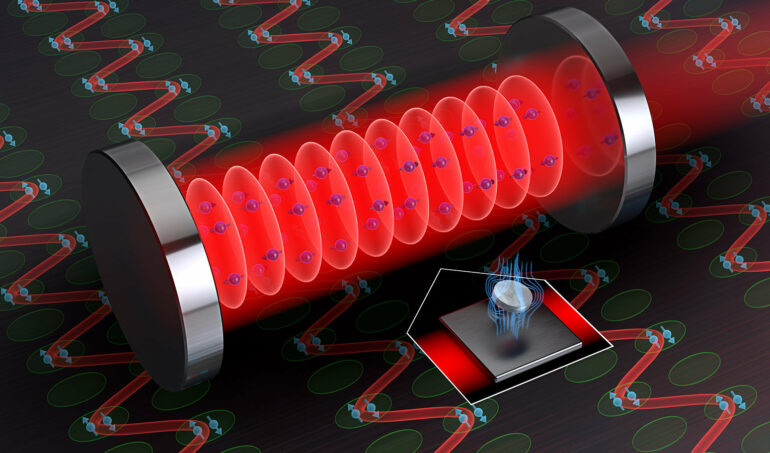In physics, scientists have been fascinated by the mysterious behavior of superconductors—materials that can conduct electricity with zero resistance when cooled to extremely low temperatures. Within these superconducting systems, electrons team up in “Cooper pairs” because they’re attracted to each other due to vibrations in the material called phonons.
As a thermodynamic phase of matter, superconductors typically exist in an equilibrium state. But recently, researchers at JILA became interested in kicking these materials into excited states and exploring the ensuing dynamics. As reported in a new Nature paper, the theory and experiment teams of JILA and NIST Fellows Ana Maria Rey and James K. Thompson, in collaboration with Prof. Robert Lewis-Swan at the University of Oklahoma, simulated superconductivity under such excited conditions using an atom-cavity system.
Instead of dealing with actual superconducting materials, the scientists harnessed the behavior of strontium atoms, laser-cooled to 10 millionths of a degree above absolute zero and levitated within an optical cavity built out of mirrors.
In this simulator, the presence or absence of a Cooper pair was encoded in a two-level system or qubit. In this unique setup, photon-mediated interactions between electrons were realized between the atoms within the cavity.
Thanks to their simulation, the researchers observed three distinct phases of superconducting dynamics, including a rare “Phase III” featuring persistent oscillatory behavior predicted by condensed matter physics theorists but never before observed.
These findings could pave the way for a deeper understanding of superconductivity and its controllability, offering new avenues for engineering unique superconductors. Moreover, it holds promise for enhancing the coherence time for quantum sensing applications, such as improving the sensitivity of optical clocks.
Identifying superconducting phases
The JILA team focused on simulating the Barden-Cooper-Schrieffer model, which describes the Cooper pair behavior. As co-first author and JILA graduate student Dylan Young said, “The BCS model has been around since the 1950s and is central to our understanding of how superconductors work. When condensed matter theorists began studying the out-of-equilibrium dynamics of superconductors, they naturally started with this model.”
In the past few decades, condensed matter theorists have predicted three distinct dynamical phases for a superconductor to experience when it evolves. In Phase I, the strength of superconductivity decays rapidly to zero. In contrast, Phase II represents a steady state in which superconductivity is preserved.
However, the previously unobserved Phase III is the most intriguing. “The idea of phase III is that the strength of superconductivity has persistent oscillations with no damping,” explained JILA graduate student and co-first author Anjun Chu.
“In the phase III regime, instead of suppressing the oscillations, many-body interactions can lead to a self-generated periodic drive to the system and stabilize the oscillations. Observing this exotic behavior requires precise control of experimental conditions.”
To observe this elusive phase, the team leveraged the collaboration of theory from Rey’s group and experiment from Thompson’s group to create a precisely controlled experimental setup, hoping to fine-tune the experimental parameters to achieve Phase III.
Creating precise simulations in a cavity setting
While researchers previously tried to observe Phase III in real superconducting systems, measuring this phase has remained elusive due to technical difficulties. “They didn’t have the right ‘knobs’ or readout mechanisms,” explained Young. “On the other hand, our implementation in an atom-cavity system gives us access to both tunable controls and useful observables to characterize the dynamics.”
Building on previous work, the researchers trapped a cloud of strontium atoms within an optical cavity. In this “quantum simulator'”, the atoms emulated Cooper pairs and experienced a collective interaction that parallels the attraction experienced by electrons in BCS superconductors.
“We think of each atom as representing a Cooper pair,” Young explained. “An atom in the excited state simulates the presence of a Cooper pair, and the ground state represents the absence of one. This mapping is powerful because, as atomic physicists, we know how to manipulate atoms in ways you just can’t with Cooper pairs.”
The researchers applied this knowledge to induce different phases of dynamics in their simulation by a process known as “quenching.” As Young said, “Quenching is when we suddenly change or ‘kick’ our system to see how it responds. In this case, we prepare our atoms in this highly collective superposition state between ground and excited states. Then, we induce a quench by turning on a laser beam that gives all the atoms different energies.”
By changing the nature of this quench, the researchers could see different dynamical phases. They even devised a trick to observe the elusive Phase III, which involved splitting the cloud of atoms in half. “Using two clouds of atoms with separate control over energy shifts is the key idea to achieve Phase III,” Chu remarked.
In superconductors, energy levels of electrons can be split into two sectors, largely occupied or barely occupied, separated by the Fermi level. “Our setup in spin systems does not have a Fermi level intrinsically, so we take account of this using two atomic clouds: one cloud simulates the states below the Fermi level, while another cloud simulates the other [quantum] states,” Chu added.
To measure the dynamics of the superconductor within the cavity, the researchers tracked the light leaking from the optical cavity in real time. Their data found distinct points where the simulated superconductor transitioned between phases, eventually reaching Phase III.
Seeing the first measurements of Phase III surprised many of the team. As Thompson stated, “Actually seeing the wiggles was extremely satisfying.” For her part in the collaboration, Rey was just as excited to see the theory and experiment align.
“On the theory side, BCS superfluids/superconductors could, in principle, be observed in actual degenerate fermionic gases, such as the ones Debbie Jin at JILA taught us how to create. However, it has been hard to observe the dynamical phases in these systems. We predicted back in 2021 that all BCS dynamical phases could instead manifest in an atom-cavity experiment. It was so nice to see our theory predictions become a reality and actually observe the dynamical phases in a real experiment.”
Underlying physics with broader applications
While observing Phase III within their system was a significant achievement, the team also found that the measured behaviors could have wider implications beyond superconductivity. As Thompson elaborated, “In terms of the underlying model that you use to describe it, it turns out that this BCS model has all these connections to different types of physics at different energy scales, temperature scales, and timescales, from superconductors to neutron stars to quantum sensors.”
Rey added, “These observations really open a path to simulate unconventional superconductors with fascinating topological properties for realizing robust quantum computers. It will be fantastic to emulate even toy models of these complex systems in our atom-cavity quantum simulator.”
More information:
Observing dynamical phases of BCS superconductors in a cavity QED simulator, Nature (2024). DOI: 10.1038/s41586-023-06911-x , www.nature.com/articles/s41586-023-06911-x
Citation:
Simulation observes three distinct phases of superconducting dynamics (2024, January 24)



